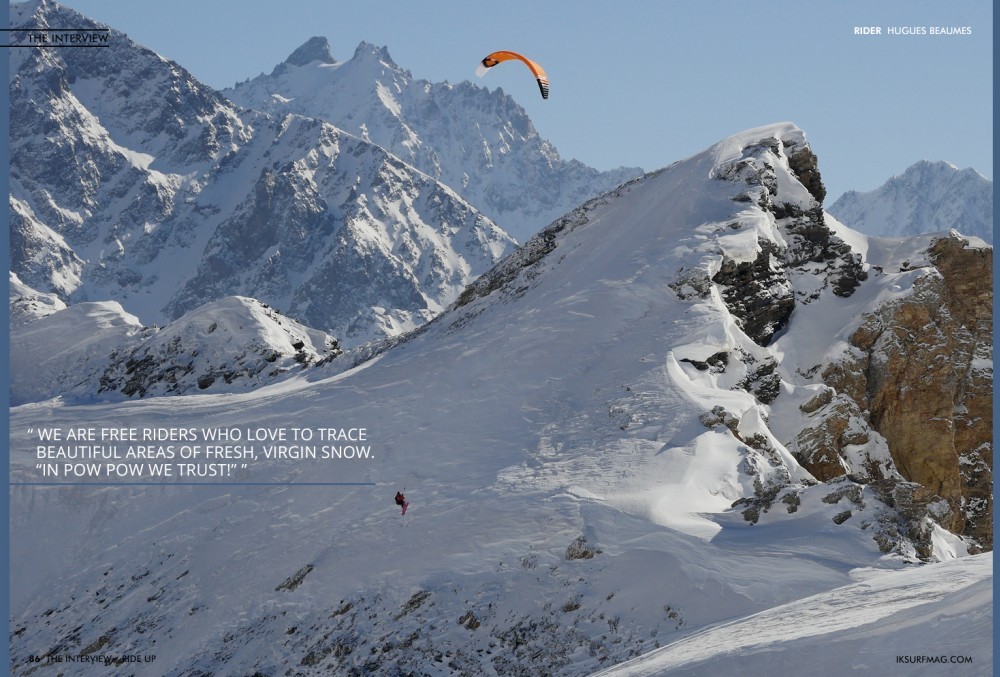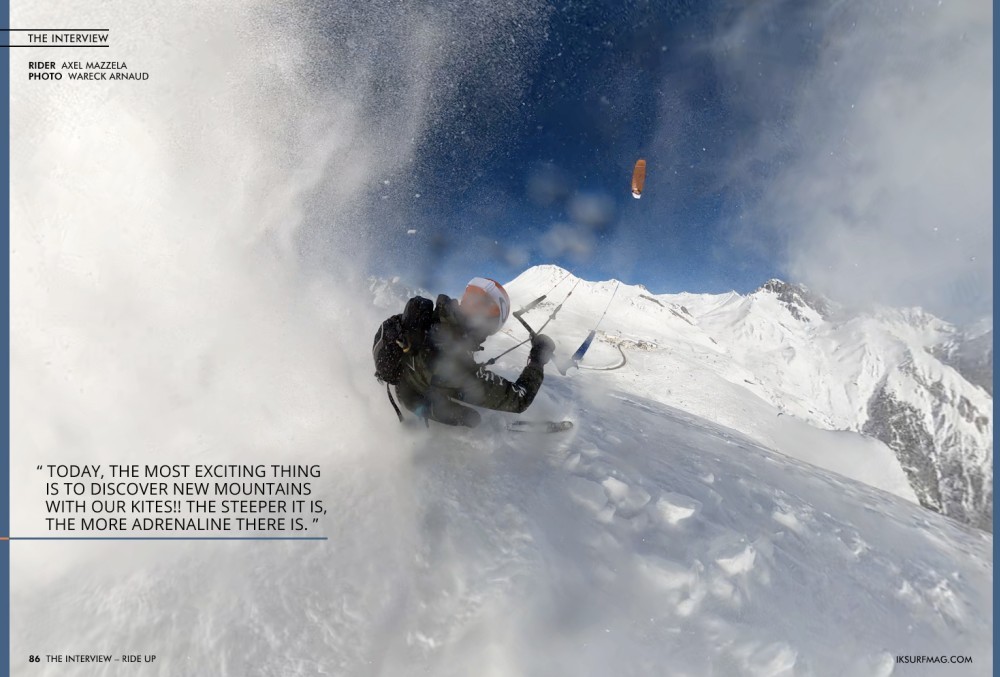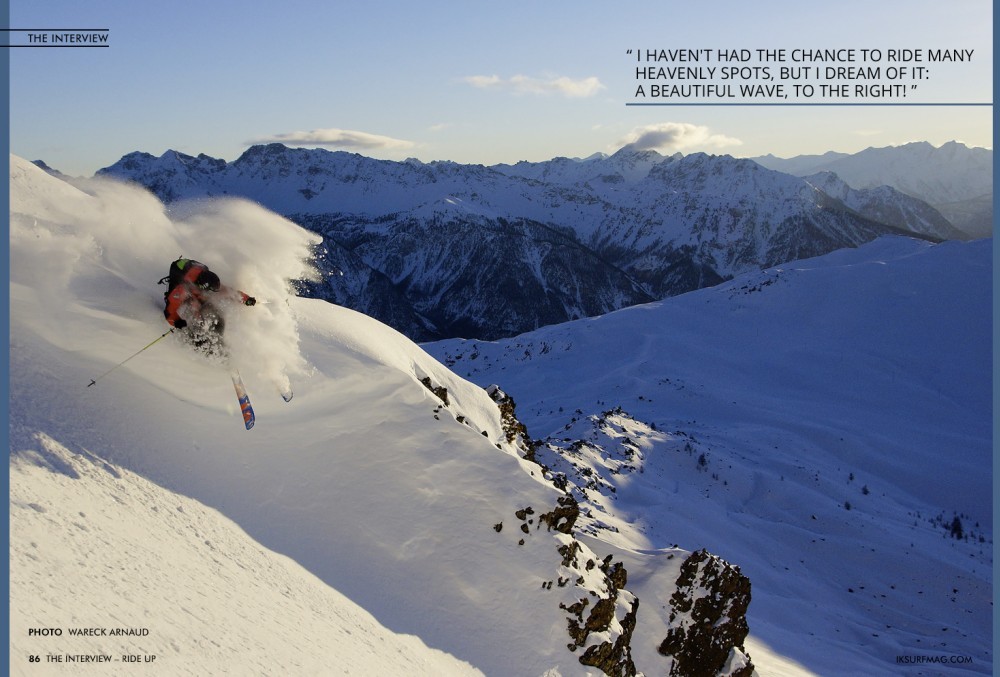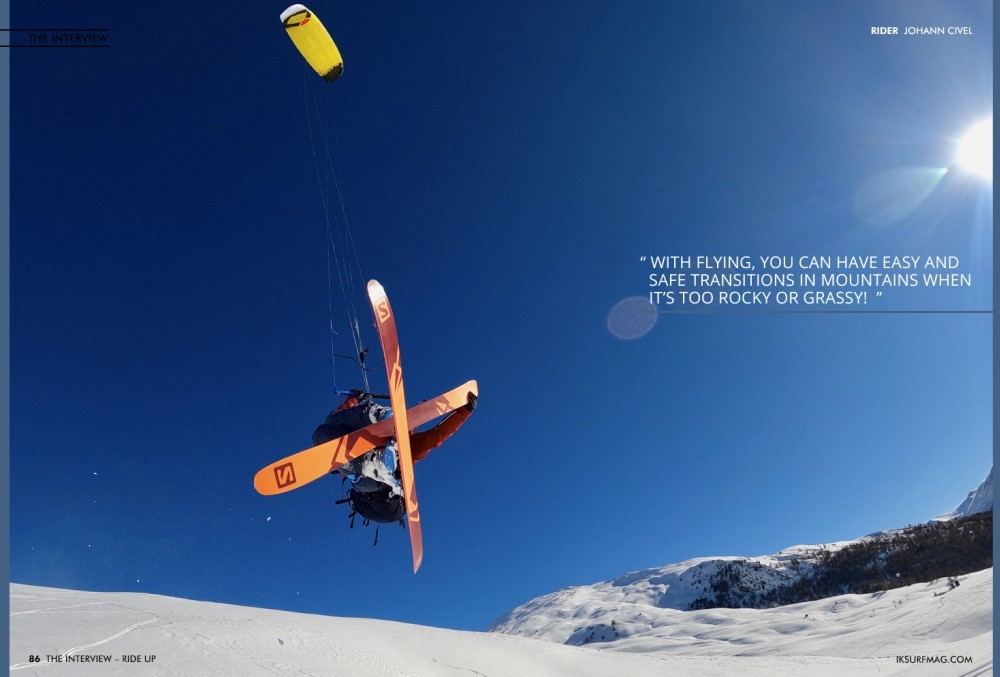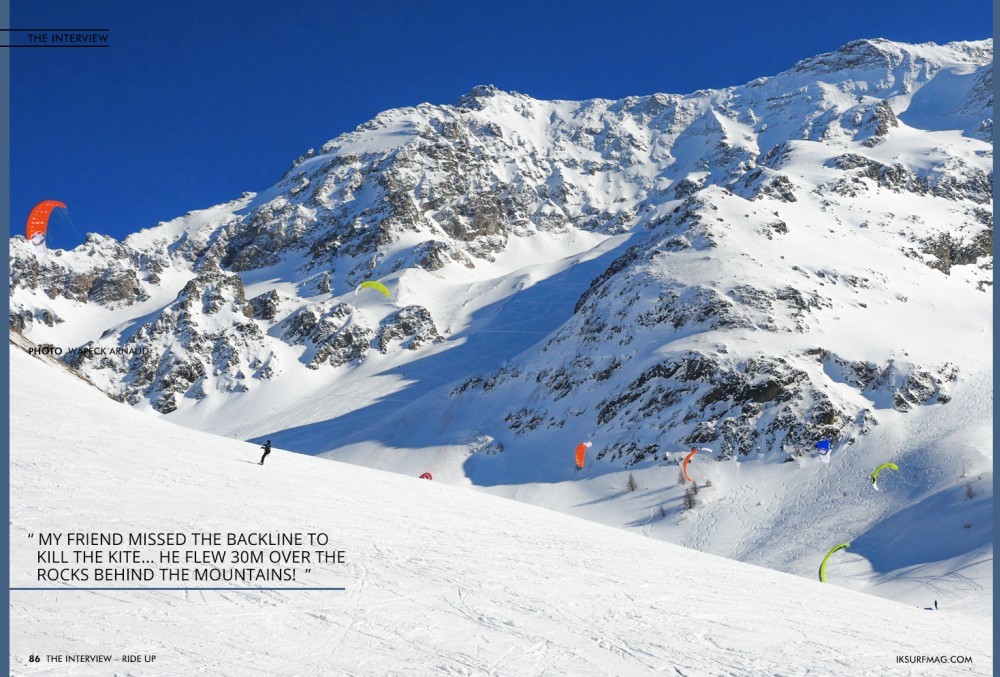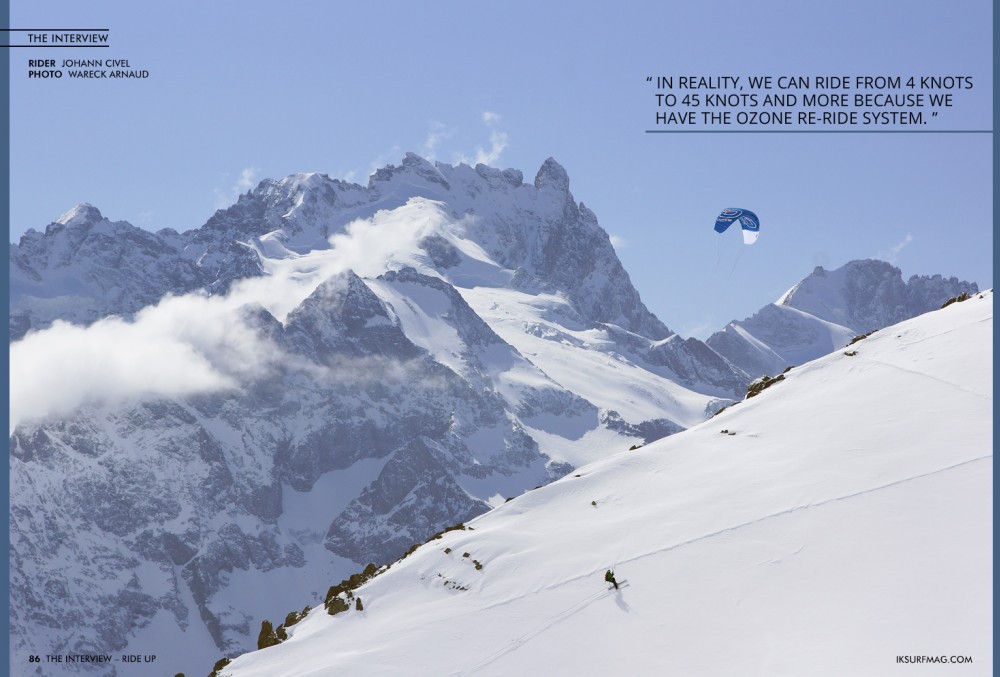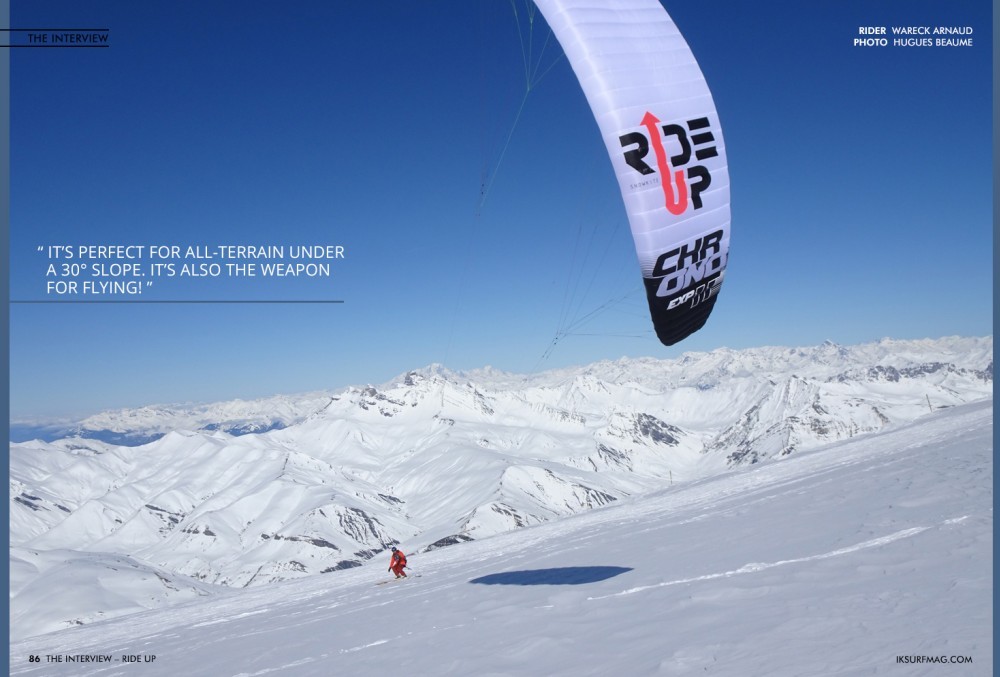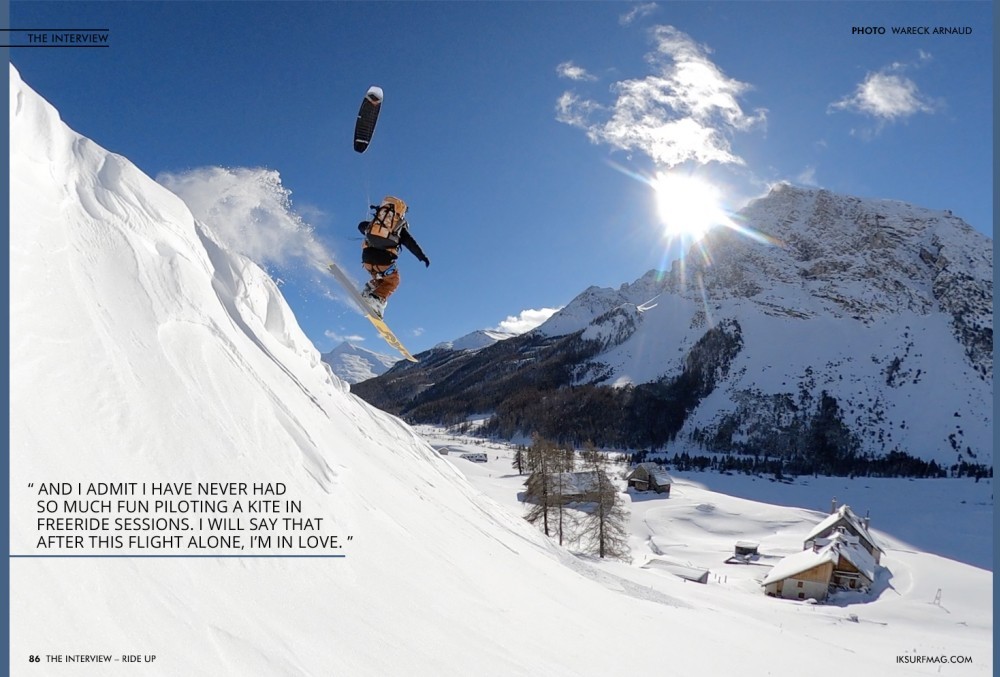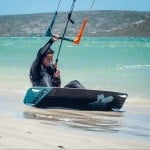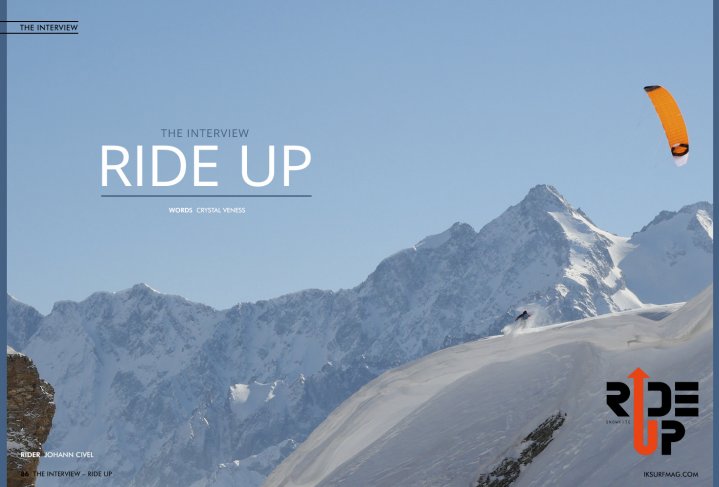
The Interview: RideUp Mountains
Issue 86 / Tue 13th Apr, 2021
This group of guys has risen to the top, conquering unimaginable peaks with the help of their kites. Is there any mountain top out of reach for the RideUp crew?! In this edition of The Interview, we chat to Wareck, Hugues, and Johann to find out what it means to make the most of winter!
First things first, what is RideUp?
Wareck: RideUp Mountains was formed with me, Johann Civel, and Hugues Beaume. We include all riders who are as intoxicated by the summits as we are.
The term RideUp has now passed into the collective language of snowkite enthusiasts. In our language, it means... going with great pleasure, riding by kite, with no walking, to the top of a mountain. Once you get to the top, as we did in the past with ski lifts and with helicopters, you arrive at the ultimate moment when you appreciate the landscape before checking the line that you are going to ski or snowboard down.
Above all, we are free riders who love to trace beautiful areas of fresh, virgin snow. “In pow pow we trust!”
How did the group come together?
Wareck: The name RideUp is a tribute to those who inspired me when I was young, the “Men Who Ride Mountains”. It was a Quiksilver advert featuring Serge Vitelli, Jean-Philippe Garcia, and Yvan Dieng. They looked like cowboys!
The RideUp project was made possible thanks to the Ozone team. I appreciate their positive energy and that we can share our common passion and create beautiful images. For several years in the Hautes-Alpes of France near the “Col du Lautaret”, we were snowkiting with Matt Taggart (Co-founder), Rob Whittall (Designer), Dominik Zimmermann (Assistant Designer), Hannes Burner (Team Coordinator), and Iain Hannay (General Manager). We have been on mythical and mystical trips to Norway and New Zealand with the Ozone dream team.
We have the same energy, which motivates us to develop and use the best tools to make the most of our passion, snowkiting. We are happy and proud to be at their side.
Most of your sessions are centred around the South Alps of France. Which spot is your favourite and why?
Johann: All the mountains can be a spot! So it's hard to say which is our favourite. Today, the most exciting thing is to discover new mountains with our kites!! The steeper it is, the more adrenaline there is.
Wareck: Of course, the favourite spot is the one we will discover tomorrow, and for sure, we will manage to climb to the top! Otherwise, my best memory is a secret spot and the place it all began, the basic, the faithful, the famous Hawaii of Snowkiting: the Col du Lautaret. It is a landscape that looks like a waking dream in paradise.
What is your kiting background, and how long have you been kiting for?
Hugues: I started snowkiting in 1999. For the first 5 or 6 years, we only did freestyle. Once the materials evolved, we began to go into the mountains.
Johann: I started snowkiting and kitesurfing in 2000 with a 2-line kite. It was so dangerous! I don't have the same motivation for water, as it's hard to find good wind and waves, but my passion is still the same in the snow.
Wareck: My journey is that of an enlightened person who needs to slide (slide being art like dancing or medicine like yoga) to consider life more in feeling than in reflection. I was skiing, monoskiing, and snowboarding while working in Montpellier. I was trying to do a little surfing in the Mediterranean when I first saw a kitesurfer. I then bought a traction kite to be towed on the beach in 30 knots.
I went back to live in the mountains to make snowboard films and spoke about this idea to Guillaume Chastagnol (2nd at the X Games snowboard halfpipe and future snowkite legend). We tested, approved, and then met other illuminated individuals. Thus began the golden age of snowkiting at Lautaret. This was in 1998.
Did you learn to kite on water or on snow? What is your favourite spot to kite on water?
Hugues: I have only been to kite on the water once. Etienne Lôthe drove me to Dakhla in 2009 for 15 days. It was nice but flat. It must be better in the waves, but I think I should stay on the frozen water!
Wareck: I started with snowkiting. After three great winter seasons, it amused me to say that I only had three days of water practice. When I kitesurf, I ride in the Mediterranean towards Montpellier and the surrounding area, where strapless riding is excellent. I haven't had the chance to ride many heavenly spots, but I dream of it: A beautiful wave, to the right!
Johann: My best kitesurfing spots have been French Polynesia and Peru, where the waves and wind are perfect! Now in summer, I live in Vendée, where there are many good spots. I love surfing without a kite, so my focus on water is riding strapless.
What ignited your passion for snowkiting?
Hugues: I was ski patrol in “Les Deux Alpes”. On my days off, I would go skiing off-piste because I was fed up with people and a chair lift! One day, I tried a tiny kite, and I thought maybe a bigger one could carry me to the top of the mountain. It took me 10 years, but I finally arrived.
Johann: The love of the mountain and this incredible pleasure that comes from playing with a power kite. Twenty years ago, I learned that the kite can bring me to the top of the mountains.
Wareck: It’s this tremendous adventure, an epic experience that I have shared and that I continue to share with my friends. The limits continue to be pushed back. Finally, we can say to ourselves that we were visionaries.
We’ve seen some pretty wild videos of snowkiters soaring over the mountain peaks that look more like flying than kiting. How do you get air in the mountains safely?
Hugues: A kite is not made to fly! But the original skis were not built to jump cliffs. When I see King of the Air, I don’t think I take too much risk! In the snow, it is essential to know how to fly because it can be an escape from a bad situation. With flying, you can have easy and safe transitions in mountains when it’s too rocky or grassy! Also, because it’s super funny!
Wareck: Love the wind, and the wind will help you. In terms of security, it depends on the day, your snowkiting level, and your comfort zone. You have to look at the weather forecast, know how to analyse it, mix it with your knowledge of the spot and how you feel, and on D-day, see if you can experiment with new trajectories. Also, check your equipment because a kite is sold with the disclaimer that it “is not made to fly”.
Johann: You have to fly gradually... don’t start at the top of the slope!! Start from the bottom. Take the time to feel the wind and see if it’s suitable for flying.
Some of the steep peaks that you climb with the assistance of your kite look impossible, yet you still manage to get to the top! Is there any fear when you’re looking straight up or down one of these steep mountain faces?
Hugues: When your kite is flying as you ride up, the mountains look flat, and there is no fear! But on the way home, when you look back, it’s totally amazing and surreal.
Johann: You just feel the steep slope when you look backwards or when your kite does not have enough power to pull you up. On the way up, you are too concentrated to feel fear... But on a 50° slope, the fear starts when you start skiing down.
Wareck: The latest exploits and world firsts that have been achieved by Johann Civel and Hugues Beaume have earned my maximum respect. I have to do more physical preparation because my limit is 35/40°. Remember that you also have to be able to descend the slopes without the kite!
Riding off-piste in some of these raw, natural conditions has to have some risks associated. Do you need any special equipment to explore the backcountry and mountain tops?
Hugues: In the end, it’s just ski touring or hiking with a kite, so you need all the same material... just add a kite!
Johann: The main danger of snowkiting in the mountains is the mountains! We always have an avalanche beacon, avalanche backpack with an airbag system, shovel, probe, radio, and sometimes crampons and poles. On the glacier, we need more equipment.
Wareck: I just have the basic shovel and probe equipment. If I wanted to pass the course to follow Jo and Hug into the mountain corridors, I would need ice axes, crampons, etc. Since I often have shooting equipment, it is always quite heavy, and it’s not easy to follow them. Therefore, I always consider making all of my equipment lighter. It is all a question of grams.
Have you ever seen it go wrong out in the alps?
Johann: The worst thing I have seen was while filming with friends on the top of the mountains. We wanted to ride all the way to the top on skis. When it was time to stop the kite, my friend missed the backline to kill the kite... He flew 30m over the rocks behind the mountains! Luckily, he landed in the snow, and everything was okay. Now, he always uses the 5th line!
Hugues: We had a lot of times where it’s gone wrong... Avalanches, missing the break line at the top of the mountain, falling in a ravine, losing a kite on a glacier with no way to go down. We can only read books on this subject. We try to learn from our mistake and not do it a second time.
Wareck: A bit like a storm at sea, even if it galvanises and exhilarates us, we have to pay attention to our equipment and the risks that we can encounter. Everything goes well if we are humble when we face the mountains.
What wind range do you need to snowkite?
Wareck: It depends on the playground and the snow’s quality, and the size of kite you have. The ideal wind range is 8 knots to 35 knots with kites from 15m to 4m. In reality, we can ride from 4 knots to 45 knots and more because we have the Ozone re-ride system.
I no longer do freestyle, rather freeride. My favourite conditions are 35 knots and 50cm of snow on a twin tip snowboard or 25 knots and 30cm of snow on skis for a fast and frenzied ride up the mountain.
Why do you use foil kites instead of inflatable kites for snowkiting?
Johann: Autonomy, easy to pack in 1 minute, ready in 1 minute, and no pump needed. It's light, and you can entirely kill the power with the 5th line.
Hugues: What is “inflatable kite”?
Skis or snowboard? Is one easier than the other?
Wareck: I started snowboarding, but of course, learning while skiing is easier. I choose based on the expected route and the quality of snow. I have a preference for snowboarding in fresh snow.
Johann: I was snowboarding since I was 7 years old. Now, I have stopped snowboarding. It’s 10 times easier on skis than a snowboard. On skis, you have 2 edges instead of one, and you can move your feet! If you start, come on skis.
Hugues: If you are called Guillaume Chastagnol or Simone Borgi, you can take a snowboard. For all the rest, take skis.
What equipment are you using out there? Why?
Hugues: Five years ago, I had a deal with a brand of kites, but now I prefer to pay to have Ozone kites because they are safe and perform just like I want! I use the Subzero for the climb, Chrono for open spaces, and Explore 4m for the storms.
Johann: For the skis, I use ski touring equipment. I use the Subzero for the kites. It’s the most versatile kite from Ozone, from flat terrain to the steepest mountains. But I like performance, so I fly the Chrono Explore 11m. It’s perfect for all-terrain under a 30° slope. It’s also the weapon for flying!
Wareck: For several years, our kites have been equipped with the Ozone re-ride system. It is ultra-efficient and reassuring in many situations. It allows us to evolve with a free spirit because, at any time, we can put the sail on the ground, cancel its power, and store it easily.
It is also thanks to this that we can engage in wild RideUp, to the max!! Big up, and thank you to the Ozone dream team for allowing us to progress in our practice of this magical sport by developing formidable kites.
Last week, we just tested the Subzero V2 model, and I admit I have never had so much fun piloting a kite in freeride sessions. I will say that after this flight alone, I’m in love.
What was your most exciting session in the 2020/2021 winter season? What happened?
Hugues: Easy, we did not have many good conditions this winter, so it was riding up the NW corridor of Trois-Évêchés. Now, I’m asking what we can do next...
Johann: Riding up the craziest couloir of my life, 1000m elevation and slope between 40° and 50°!
Wareck: I lived it by proxy. It was the world premiere of Johann and Hugues ascending the corridor of Trois-Évêchés. The season is not over, and we have plenty of surprises in store. I have the perfects kites, and the mountains are beautiful in April and until mid-May. There are 45 days left to satisfy our thirst for freedom, to express our joy of riding with friends on our heavenly planet. We are going to have a great time. Don’t hesitate to come and see us and follow us on Facebook and Instagram.
How has the COVID-19 pandemic affected snowkiting at your local spot? Are there more kiters on the slopes nowadays?
Johann: Many people want to try snowkiting, but on a visit to the Alps in a typical year, they would buy a ski pass for the week... So they could never find the time to go snowkiting! This winter, there was nothing but time. So the spot (Lautaret Pass) was completely full of beginners, which is a good thing for the sport.
For any kiters considering a snowkite trip or snowkite season for the first time, what should they know before they go? Do you have any advice to share?
Hugues: Have fun, but don’t forget that snowkiting is not kitesurfing in the mountains.
Johann: Snowkite school first!
Videos
By Crystal Veness
Editor at IKSURFMAG, Crystal Veness hails from Canada but is based in South Africa. When she isn't busy kitesurfing or reporting on the latest industry news for the mag, she is kicking back somewhere at a windy kite beach or working on creative media projects.




